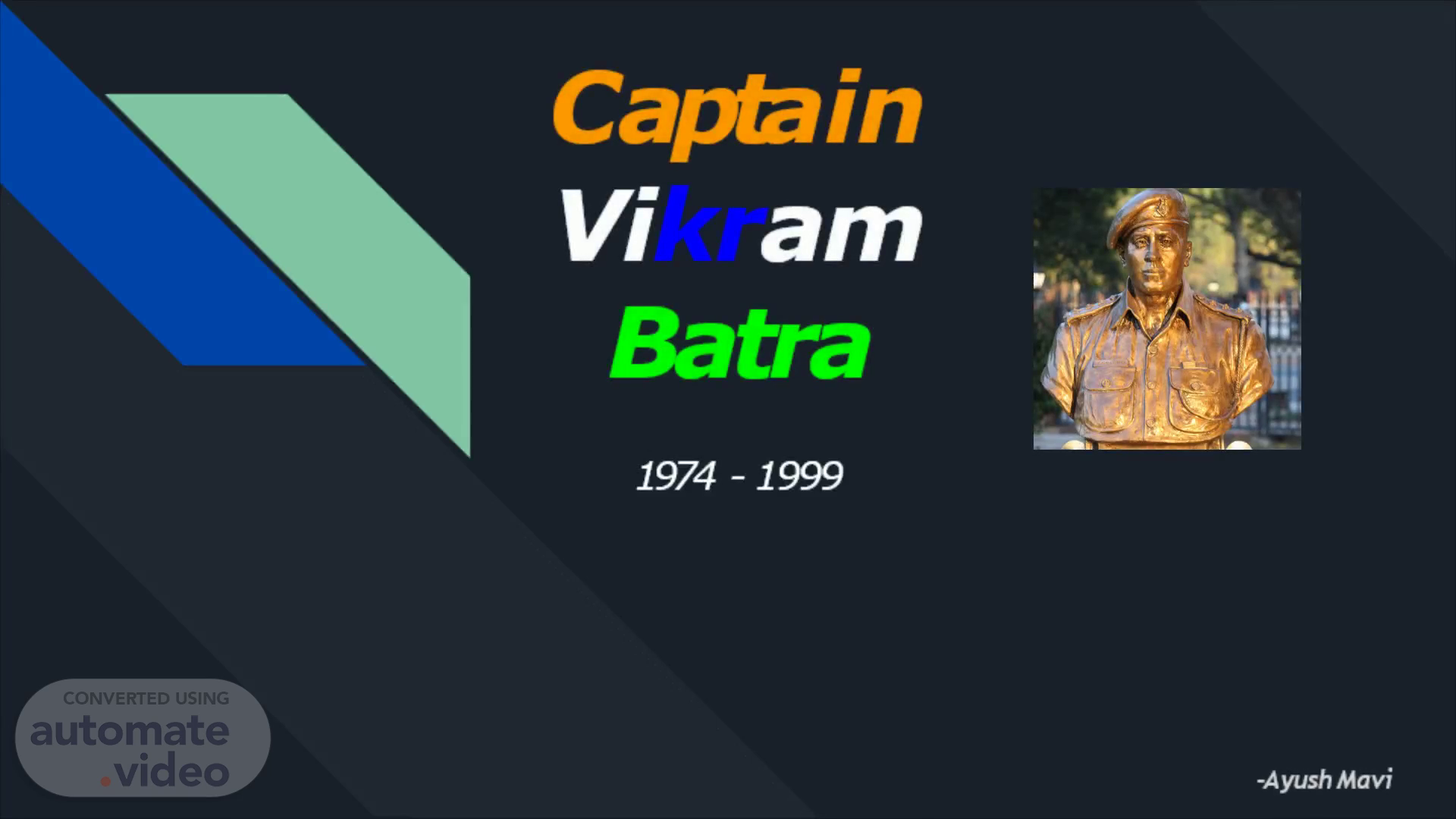
Page 1 (0s)
C ap t ain Vi k r am Ba t ra. 1 9 7 4 - 1999. - A yush Mavi.
Page 2 (8s)
Captain Vikram Batra was born to a family of teachers, his father a principal of a government school and his mother a school teacher. Batra was active in sports during his school time, especially in table tennis and karate, in which he was a green belt holder. Batra attended the DAV college in Chandigarh, enrolling in Bsc Medical Sciences. It was during his stint at the DAV college that he became a cadet with the National Cadet Corps (NCC). He was adjudged the best NCC Air Wing cadet of Punjab Directorate, North Zone, during the inter-state NCC Camp. Batra soon worked his way up to become the Senior Under Officer at his NCC unit and eventually marched at the Republic Day Parade in 1994. That’s when he told his parents he wanted to join the army..
Page 3 (42s)
Batra also had an offer from a shipping company headquartered in Hong Kong to join the merchant navy. But Batra declined the offer and enrolled in a MA English course at Panjab University instead, so he could prepare for the Combined Defence Services (CDS) exam. Batra took the CDS exam and was selected by the Services Selection Board (SSB) at Allahabad in 1996. In the order of Merit, Batra was among the top 35 recruits. After completing an year in his MA course, Batra joined the Indian Military Academy(IMA) in Dehradun and was part of the Manekshaw Battalion. He completed a rigorous 19-month training course and was commissioned into the Indian Army as lieutenant in the 13th battalion, Jammu and Kashmir Rifles. He received his first posting to Sopore, Baramulla, after he underwent additional training in Jabalpur, Madhya Pradesh..
Page 4 (1m 18s)
Sopore was an area of significant militant activity, and Batra had many skirmishes with the militants. Batra also undertook the Commando course in Belgaum and was awarded the highest honour — that of an Instructor’s Grade. THE KARGIL WAR Batra’s battalion, the 13 JAK Rifles came to Drass in early June. By then, the Kargil conflict had been underway for a month and had escalated to a full-out war. Irregular and regular Pakistani troops had infiltrated into the Indian side of the Line Of Control and captured strategic Indian territories. The Indian Army, with the help of the Indian Air Force, had launched Operation to reclaim the territories..
Page 5 (1m 47s)
Batra’s battalion, the 13 JAK Rifles were to act as reserves to the 2nd battalion, the Rajputana Rifles. The 13 JAK Rifles played a significant role in the capture of Point 5140 under the leadership of Lt Col. Yogesh Kumar Joshi. It was during the briefing for the capture of Point 5140 that Batra used the phrase ‘Yeh Dil Mange More’ – taken from a popular Pepsi ad campaign – as his success signal. Batra was severely injured during the attack, but he killed three enemy combatants and a large number of arms and ammunition were recovered..
Page 6 (2m 13s)
India didn’t suffer a single loss of life during the capture of Point 5140. In fact, the victory started off a string of successful recaptures, and the Indian army captured Point 5100, Point 4700, Junction Peak and the Three Pimple Complex. Lieutenant Batra’s triumph at Point 5140 had been played across on national TV. General Ved Prakash Malik, the then Chief of Army Staff had called Batra up personally to congratulate him on the triumph. Batra, who was still a lieutenant at that point, was promoted to the rank of a Captain. In the meanwhile, his battalion the 13 JAK Rifles was sent to Mushkoh valley, under the command of 79 Mountain Brigade. The battalion was assigned the task of recapturing Point 4875, a peak that held significant strategic importance, for it dominated National Highway 1, right from Dras to Matayan..
Page 7 (2m 52s)
SLEE P PE A CEFUL L Y A T Y OUR HOMES , INDIAN ARM Y IS G U ARDIN G THE FRONTIERS.